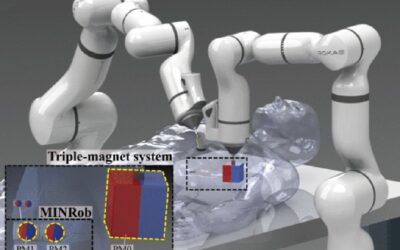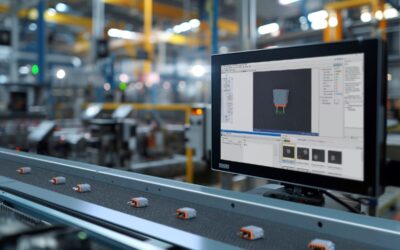In this exclusive interview with MVPro Media, WTWH’s Steve Crowe shares his expert insight on the emerging technologies in robotics.
Crowe, who works as the Executive Editor of Robotics at WTWH Media, discusses the advancements in artificial intelligence (AI) and the e ect this has had on robotics. He also shares his views on humanoid robots, which have become a major topic of conversation. He then explains the rise in logistics robots and reveals more about WTWH’s upcoming Robotics Summit & Expo.
Q: Can you tell us about WTWH and your role within the company?
We’re a fast-growing media company that has been around for 20 years. We work in a few di erent sectors, including robotics. I’m in charge of the editorial aspect of the robotics group. We also run many events, including the Robotics Summit & Expo, which is quickly approaching.
Our core audience is robotics developers, so we reach that community and try to educate them on the challenges of building and deploying robots, the experiences from the user standpoint, and keeping them up to date on emerging technologies. Our goal is to provide anything that will allow a robotics developer to do their job better.
Q: On the topic of emerging technologies, in what ways do you think the advancements in ai have improved the capabilities of robots?
This is one of the main focuses at the Robotics Summit this year. In the last year, we’ve seen the emergence of generative AI, with large language models thanks to OpenAI. Some companies are now coming out with what they call foundation models, including Covariant and Electric Sheep. These companies use generative AI to create models of the world, making their robots smarter.
Covariant conducts a lot of picking tasks within warehousing environments, trying to make their robots better at picking things up. If they encounter an object that they’ve never seen before, they’re hoping that combining these different types of technologies will help that robot perform better.
They’re also keen to make their robots easier to use from an end-user perspective. The only way that robots are truly going to be democratised in the world is if they’re easier to use. They have been extremely difficult to program, build, fi x, and redeploy.
There are different buying habits now with consumer behaviour, so these robots must be adaptable to deal with different workflows that are changing by the day. With generative AI, they’re hoping to make it easier for an end user to redeploy a robot into a different station.

Agility Robotics, which is developing a humanoid, had a notable example last year. Agility instructed its humanoid to clean up the mess in a room containing various trash bags, and certain items which needed to be recycled. That’s all the information they gave the robot, they didn’t tell the robot what mess is or how to clean something up, and by accessing the power of large language models, it was able to do that on its own.
We’re very early in that stage, and there’s a lot of work to be done. There are a lot of reliability questions that have to be answered and improved upon. I think it’s important to make the robot’s performance better, but also make it easier for end users to program it.
There are countless ways that AI is advancing robots, such as better imaging, an improved understanding of what it’s seeing, better control, and optimisation techniques with AI. That’s one of the key focuses at the Robotics Summit coming up.
Toyota Research Institute is another leader in this space and they’re hoping that they can help robots learn to complete different tasks quicker and more easily.
Q: Going back to what you said about humanoid robots. there is a bit of an ongoing debate, but where do you stand on this?
This is the debate of the moment. When I went to a recent trade show in Atlanta, humanoids came up in just about every conversation I had. It’s a fascinating debate and I’m all for it. I think we need different types of robots to get out there in the world.
I know there are a lot of people, especially those in the robotics community, who are against humanoids. They don’t think the form factor makes any sense. One of the main reasons is the battery life, which is a significant challenge for humanoids going forward. Those who are against humanoids might say, “Why do they need to have legs? Just throw them on a wheeled mobile base and you increase the efficiency.” With that, you’ll get more battery life.
Humanoids promise to be more flexible, and more easily integrated into an existing facility, because they do have somewhat of a human form factor, meaning they have two legs and two arms. If it’s interacting with a shelving unit at an Amazon warehouse, for example, those shelves are designed to be worked on by humans. So, there’s all sorts of retrofi tting that comes with having mobile robots.

Moving towards robots that can do multiple tasks is beneficial for many reasons. It helps customers solve their labour shortages, which also makes them more valuable for end-user customers. I think it’s going to be a little while before we start to see them commercially deployed in a warehouse or manufacturing environment at a large scale. They need to prove their reliability and get some pieces of the puzzle in place when it comes to what customers would expect from a commercialisable product.
Agility Robotics are keynoting at our Robotics Summit & Expo. Their Co-Founder and Chief Robot Officer, Jonathan Hurst, is going to take our attendees through what they’re doing and how they’re doing it. They’re out in early customer deployments and are leading the pack. They recently came out with a fleet management system, which is vital for any type of robot that’s going to have commercial viability.
When it comes to deploying humanoids for consumers and at our homes, you see some of these humanoid companies saying that every person is going to own one to help carry out personal tasks. I don’t buy into that aspect of it.
It’s going to be relegated to different types of low hanging tasks within a warehouse, like moving boxes. We’re also going to have Amazon robotics keynoting at our Robotics Summit & Expo, they are one of the early partners for Agility Robotics from both an investment and a deployment standpoint. They have publicly backed Agility Robotics, saying this is something that’s going to help them throughout their logistics facilities going forward.
When you have players like that and GXO Logistics, and you see Tesla and BMW trying them, I think it is only a matter of time before that happens. There are certainly some challenges that those robots must overcome before they’ll be able to do that at any sort of real scale.
Q: What do you think is driving the adoption of logistics robots?
I think the labour shortage has had a major ect. The pandemic expedited the growth of e-commerce, introducing a lot of new folks to e-commerce out of necessity. That whole concept of e-commerce is still quite new, I remember back in the early days of Amazon, when it would take a week to get something shipped to your house.
As consumer expectations are increasing, the number of workers who want to work for online e-commerce players is decreasing. That creates a major problem; If we want to get our packages, we need some answer to the problem. That’s the main driver of this, being able to fulfil all these orders reliably on time.
These robots are not stealing jobs, they’re not sentient. They’re not really all that intelligent at this point, they’re there to augment the human workforce and help them be more productive. The amount of turnover is crushing for manufacturing businesses, people will leave a job if a competitor makes a few more dollars per hour, leaving companies with major problems.
To counter this, they are trying to build a reliable production workforce. I think the only way to do that going forward is through robotics. Online players are trying to keep up with their competitors and keep customers happy.
Q: Is there anything else you’d like to share with our readers that we haven’t discussed?
Our flagship show the Robotics Summit & Expo takes place 1st- 2nd of May in Boston. It’s a great robotics community, arguably the leading robotics community in the world. This event gets people together for two days of networking and learning, to push forward the commercial robotics industry.
We’re going to have 5000-plus representatives from the commercial robotics development ecosystem there. We have keynotes from Agility Robotics, Amazon, Disney, Teradyne Robotics, and Medtronic. There are going to be plenty of cutting-edge robots which are starting to emerge in the real world and help customers be productive.
We get together the leading end users, integrators, developers and users for a couple of days to try to move this industry forward. Robots are just starting to make their way out of research labs and out of automotive manufacturing facilities. They’re in some logistics facilities, but for these companies to remain competitive on a range of fronts, we need more robots out there.
We’re trying to help educate people on how to make them better, stronger, faster, smarter, and more effective for their customers. If you haven’t been to or heard of the event, you can check it out here. It’s on the 1st-2nd of May in Boston, and I hope to see everybody there. Steve Crowe, Executive Editor of The Robot Report and Chair of the Robotics Summit & Expo
Steve Crowe, Executive Editor of The Robot Report and Chair of The Robotics Summit & Expo

Steve Crowe is Executive Editor of The Robot Report and Chair of the Robotics
Summit & Expo. He joined WTWH Media in January 2018 after spending five years as Managing Editor of Robotics Trends and Robotics Business Review and was co-chair of RoboBusiness. Steve has produced robotics conferences for CES and PTC’s LiveWorx.





